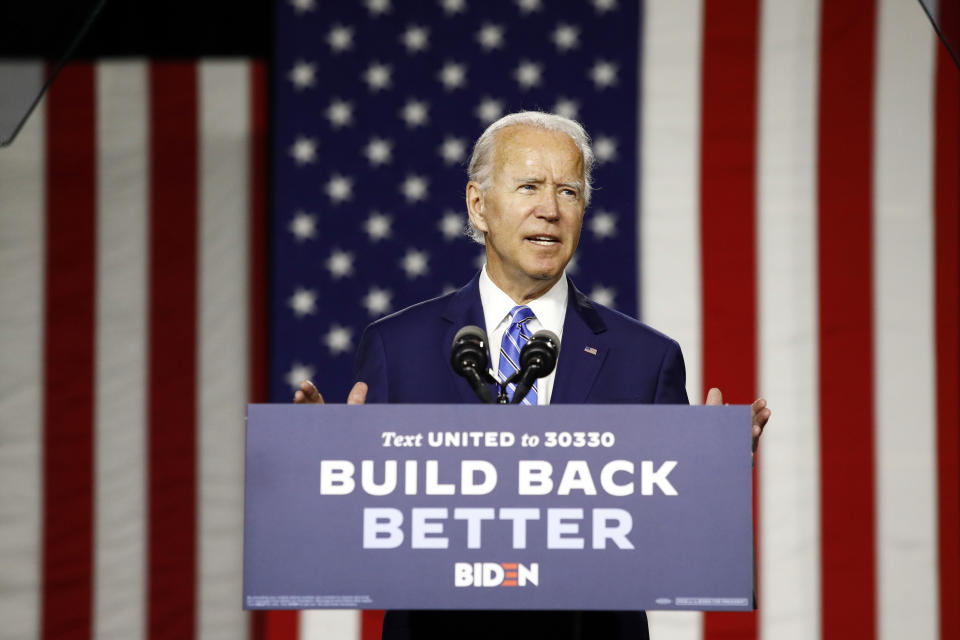Coronavirus could cost Trump 100 electoral votes
Before the coronavirus pandemic, President Trump enjoyed strong reelection odds, despite a tenure marred by controversy. Unemployment was at decade lows, stocks were at record highs and consumers felt good.
The pandemic and consequent recession could cost Trump at least 100 electoral votes—and the election—according to a new forecast by Moody’s Analytics. In February, before the pandemic metastasized in the United States, the firm’s election model forecast Trump would win reelection with 336 electoral votes, to 202 electoral votes for his Democratic challenger. That would have been a better Trump performance than in 2016, when he beat Hillary Clinton with 306 electoral votes. In addition to all the states he won in 2016, Trump would have flipped Maine, Minnesota, New Hampshire and Virginia.
But now, with the unemployment rate up from 3.5% in February to 11.1% in June, Trump is an underdog who could lose in a landslide in November. Moody’s now forecasts that Democrat Joe Biden will win with 308 electoral votes, to 230 for Trump, if turnout is around average for a presidential election. If turnout is high, like it was in the 2018 midterm elections, Biden could win with 352 electoral votes, to 186 for Trump. It takes 270 electoral votes to win.
Six swing states—Florida, North Carolina, Pennsylvania, Michigan, Wisconsin and Arizona—are crucial to the outcome in November. Trump won all of those in 2016, clinching the win. In the Moody’s average-turnout model, Trump wins North Carolina and Arizona, while Biden wins the other four. In the high-turnout model, Biden wins all 6, plus Ohio.

The Moody’s forecast isn’t a poll, but an economic model that calculates the incumbent president’s reelection odds based on changes in the unemployment rate and other factors, including historical data. Jimmy Carter lost reelection in 1980 after the unemployment rate rose 1.4 percentage points from the first quarter of 1980 to the third quarter. George H. W. Bush lost in 1992 when the unemployment rate rose just 0.3 points during the same period. Moody’s Analytics thinks the increase by the third quarter of this year will be 5.4 points, nearly four times worse than the change under Carter—who lost to Ronald Reagan in a landslide, 489 electoral votes to 49.
Other economic models show Trump in deep danger, as well. A May analysis by Oxford Economics forecast Biden winning with 328 electoral votes to 210 for Trump, and Biden getting 65% of the popular vote. That, too, was a flip from the pre-coronavirus forecast, when the firm expected Trump to win.
Polls favoring Biden
The bad news is piling up for Trump. A recent Quinnipiac poll found Biden leading Trump by 15 points nationally, the largest lead of any poll so far. Voters have generally given Trump strong marks on the economy, but that seems to be turning, too. In the Quinnipiac poll, 53% disapproved of his handling of the economy, while just 44% approved. His net approval rating on the economy dropped 16 points from June to July.
In the Real Clear Politics aggregate of polls, Biden leads Trump by 8.6 points nationally, and by low- to mid-single digits in most swing states. Trump’s approval rating is around 42%, close to the lowest of his presidency. In late March, it was around 47%, the highest of his term. A spurt of national unity pushed Trump’s approval up after he announced emergency measures to combat the coronavirus. But that has evaporated amid surging infection and death rates, civil unrest following the killing of George Floyd in Minneapolis, and Trump’s usual blame-laying and excuse-making.
The peculiar evolution of the pandemic is also working against Trump. At the beginning, it hit blue states such as New York and Washington the hardest. Those areas imposed the toughest lockdowns and endured the worst job losses in April, May and June. But many of those areas are gradually reopening, as the virus spreads to midwestern swing states and red states in the south.

The depth of the recession in deep red and blue states won’t affect the election, since those states will go for Trump or Biden no matter how bad the economy. The swing states are another story, and rising job losses in some of those ”ought to worry the Trump campaign, given the sway independent voters hold in those states,” the Moody’s Analytics analysis says. It identifies Michigan and Florida as suffering the most, and thus being most likely to flip Democratic in 2020.
Still, a Biden win is hardly guaranteed. Complacency among Democrats could lead fewer to vote, which would benefit Trump. The economy could recover more quickly than expected, and another round of stimulus spending could cheer voters. But Trump needs a break soon, and the virus isn’t going easily.
Rick Newman is the author of four books, including “Rebounders: How Winners Pivot from Setback to Success.” Follow him on Twitter: @rickjnewman. Confidential tip line: [email protected]. Encrypted communication available. Click here to get Rick’s stories by email.
Read more:
Get the latest financial and business news from Yahoo Finance
Follow Yahoo Finance on Twitter, Facebook, Instagram, Flipboard, SmartNews, LinkedIn, YouTube, and reddit.
